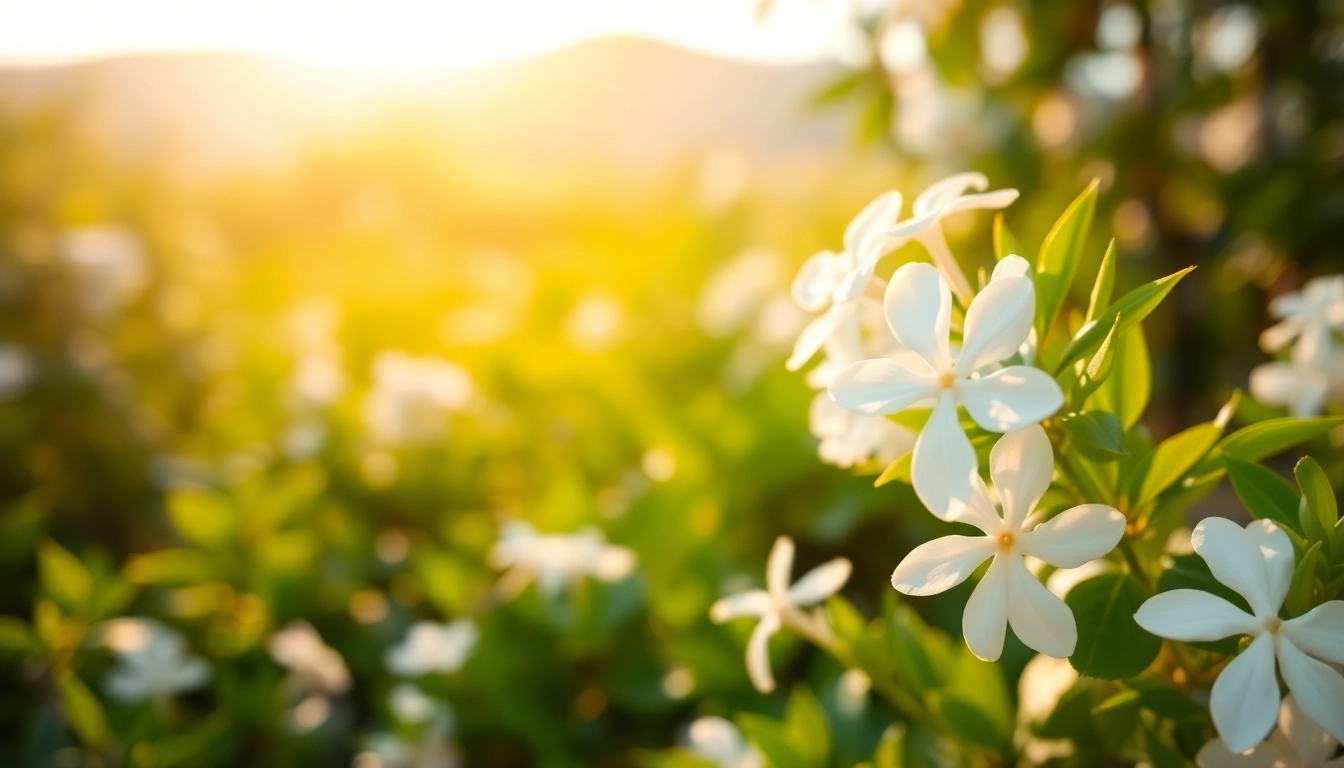A Deep Dive into Jasmine: Varieties, Care Tips, and Cultural Significance

Understanding Jasmine: An Overview
When we think of fragrances that evoke a sense of tranquility and warmth, jasmine often comes to mind. This enchanting plant, scientifically classified under the genus Jasminum, is renowned for its delightful scent that infuses gardens and perfumes alike. Jasmine encompasses around 200 species, primarily hailing from tropical and warm temperate regions across Eurasia, Africa, and Oceania. Distinctively valued for its aromatic properties, jasmine has found its place in various cultural practices, culinary applications, and health benefits. To dive deeper into this fascinating plant, let’s explore the essence of jasmine, including its varieties, care requirements, and myriad uses.
What is Jasmine?
Jasmine, part of the olive family (Oleaceae), features a mix of shrubs and vines whose flowers are widely celebrated for their captivating scent. These plants can blossom in white, yellow, or pink hues, appealing to both senses and aesthetics. The most commonly recognized species include Jasminum officinale, known as common jasmine, and Jasminum sambac, often referred to as Arabian jasmine. Their intoxicating fragrance has positioned jasmine as a staple in perfumery, aromatherapy, and traditional medicine.
Varieties of Jasmine Flowers
The world of jasmine is diverse, with many varieties each bringing unique characteristics. Let’s explore a few prominent types:
- Common Jasmine (Jasminum officinale): Known for its delicate white flowers, this variety blooms in summertime and is often utilized in teas and perfumes.
- Arabian Jasmine (Jasminum sambac): This species stands out for its exquisite fragrance and is frequently used in garlands and traditional ceremonies in many cultures.
- Star Jasmine (Trachelospermum jasminoides): While not a true jasmine, this vine is celebrated for its star-shaped flowers and lush green foliage, making it a popular ornamental plant.
- Winter Jasmine (Jasminum nudiflorum): Blooming in winter, this hardy variety features yellow flowers, adding color to the winter landscape.
Cultural Significance of Jasmine
Jasmine has a rich tapestry of cultural symbolism across various societies. In many Asian cultures, jasmine is an emblem of love, purity, and beauty. In India, the aromatic flowers are used in wedding ceremonies and as offerings in temples. Similarly, in the Middle East, jasmine blooms are intertwined into garlands as a symbol of affection. Its captivating scent has also been woven into folklore, symbolizing devotion and beauty, making it an enduring cultural staple.
Caring for Jasmine Plants
Cultivating jasmine is manageable and rewarding when you understand its care needs. These plants thrive in the right conditions, ensuring vibrant blooms and delightful fragrance.
Soil Requirements for Jasmine
Jasmine prefers well-draining soil enriched with organic matter. A mix of potting soil, compost, and sand can create the ideal acidic to neutral pH environment. Ensuring good drainage is vital, as overly saturated soil can lead to root rot. Regularly amending the soil with compost can also provide nutrients that bolster healthy growth.
Watering and Light Needs
Jasmine plants require a careful balance of moisture and sunlight. Aim to keep the soil consistently moist but not waterlogged. In general, watering once a week during the growing season and reducing it in the dormant winter months suits most varieties. As for light, jasmine thrives in bright, indirect sunlight, though some species can tolerate partial shade. Direct sunlight can scorch their leaves, so consideration of positioning is crucial.
Pruning Tips for Healthy Growth
Regular pruning is essential for maintaining the health and shape of jasmine plants. Typically, pruning should be done after blooming, where dead or overgrown stems should be trimmed back. This encourages new growth, enhances air circulation, and removes any potential pests or diseases. During the growing season, pinching back excessive growth can lead to bushier plants with more blooms.
Jasmine in Landscaping and Gardening
Jasmine’s aesthetic appeal makes it a popular choice for various landscaping applications.
Using Jasmine as a Decorative Element
Jasmine plants serve as excellent decorative additions to gardens and terraces. Their cascading vines can enhance trellises, fences, or walls, creating fragrant, lush living green screens. Additionally, many gardeners grow jasmine in pots, allowing for mobility to adjust light conditions and maximize blooming. Pairing jasmine with complementary plants, such as roses or lavender, can also boost visual and aromatic appeal.
Growing Jasmine Indoors vs. Outdoors
Both indoor and outdoor environments can successfully support jasmine growth, albeit with differing care requirements. Indoor jasmine should be placed in bright locations, receiving adequate light, while maintaining humidity through misting or humidity trays. Outdoor jasmine, on the other hand, may require adjustments based on regional climates, ensuring it’s sheltered from harsh weather. Seasonal blooms can also vary significantly, with outdoor varieties typically achieving fuller blooms through natural sunlight exposure.
Companion Plants for Jasmine
Selecting compatible plants enhances the overall health and aesthetics of a garden. Ideal companions for jasmine include:
- Roses: Their beauty complements jasmine well, and their different blooming seasons maximize the aesthetic appeal.
- Lavender: The two share similar water and sunlight needs, and lavender’s strong scent can deter pests.
- Ornamental Grasses: Their vertical growth contrasts beautifully with the cascading nature of jasmine vines.
Health Benefits and Uses of Jasmine
Beyond its visual appeal, jasmine is also valued for its health benefits and versatile uses in various domains.
Jasmine in Aromatherapy
The oil extracted from jasmine flowers serves as a powerful tool in aromatherapy, known for its calming effects that alleviate stress, anxiety, and enhance mood. Inhaling jasmine scent can promote a sense of relaxation and peace, making it a favorite in massages and diffuser blends. Research has shown that jasmine can significantly influence sleep quality and lower cortisol levels, enhancing overall well-being.
Medicinal Properties of Jasmine
In traditional medicine, jasmine has been utilized to treat various ailments. Its antiseptic and anti-inflammatory properties make it suitable for skin issues and infections. Jasmine tea is also consumed for its potential benefits in digestion and relieving menstrual discomfort. Recent studies indicate that jasmine may possess antioxidants that fight free radicals, contributing to improved health and longevity.
Jasmine in Culinary Applications
Apart from perfumery and health, jasmine is also a culinary delight. Jasmine rice, for instance, is a fragrant variety of long-grain rice known for its subtle floral aroma. It’s commonly used in Southeast Asian dishes and pairs excellently with a variety of cuisines. Additionally, jasmine flowers are sometimes used to flavor teas or craft delicate syrups that can enhance desserts and cocktails.
Finding the Right Jasmine for Your Space
Selecting the appropriate jasmine type is critical to successful cultivation and enjoyment.
Choosing Jasmine Based on Climate
Before introducing jasmine to your garden, consider the climate conditions. While some varieties are quite adaptable, others may require specific temperatures and humidity. For warmer regions, species like Jasminum sambac thrive, while cooler climates might benefit from Jasminum nudiflorum. Understanding your local climate can help avoid unnecessary issues with growth and flowering.
Buying Jasmine Plants: Tips for Selection
When purchasing jasmine plants, opt for healthy specimens with vibrant green leaves and no signs of pests or diseases. Check for strong root systems, which indicate healthy growth potential. Local nurseries often provide a selection of species suitable for your region, making them an excellent choice for first-time buyers.
Common Mistakes to Avoid When Growing Jasmine
While jasmine is generally easy to care for, there are common pitfalls to avoid:
- Overwatering: Root rot frequently occurs from over-saturated soil.
- Insufficient Light: Ensure your jasmine receives adequate light to promote blooming.
- Pest Infestation: Regularly inspect your plant for pests like aphids and spider mites.
- Neglecting Pruning: Failing to prune can result in leggy growth and fewer blooms.
By understanding and addressing these common mistakes, you can cultivate bountiful jasmine plants that thrive and produce fragrant blooms.




